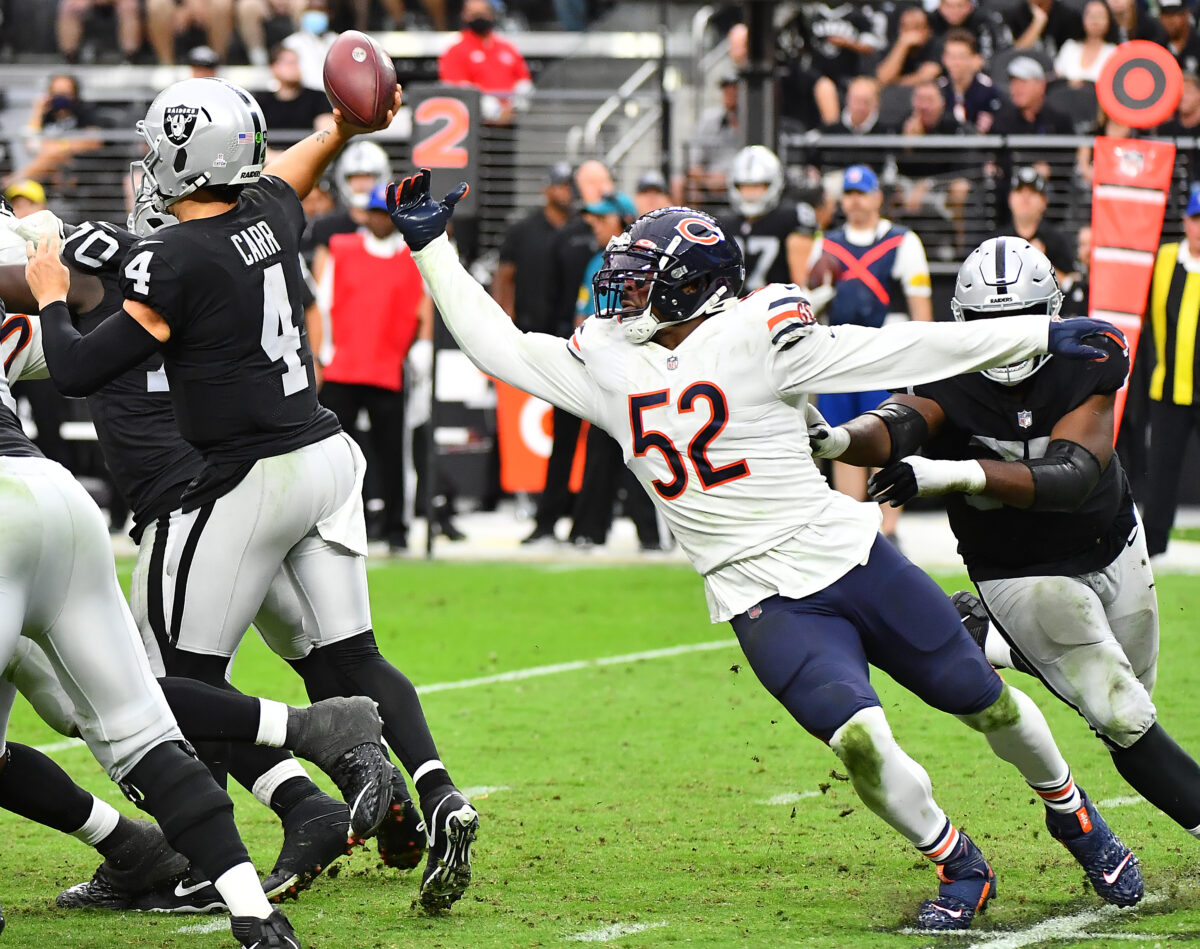The Chicago Bears are not a good football team. By trading away star pass rusher Khalil Mack, they will be even worse.
And, given the current state of their roster, it’s the right thing to do.
The Bears, a team devoid of young building blocks, traded away their top defender for a couple of lottery tickets in hopes of adding the foundational talent they lack. Chicago will reportedly receive a second- and sixth-round pick in exchange for a player they shipped a pair of first-rounders to Oakland to acquire back in 2018.
On its face, it looks like a bad deal. Mack is a former defensive player of the year. He’s only 31 years old and was an All-Pro in 2020. And he cost less for the Chargers to acquire than the Rams paid out for a 32-year-old Von Miller after he’d missed the entire 2020 campaign.
The question of whether Mack could have fetched more via trade is valid — he almost certainly could have. The question of whether it was time to sell is not. This Bears team is very, very bad and has few legitimate paths to getting better.
Who are the young building blocks who can stand as the pillars of a playoff team? The team’s two 2021 Pro Bowlers, Jakeem Grant and Robert Quinn, are both at least 29 years old (and Grant, who made the squad on special teams, is a free agent).
Justin Fields makes the cut by default as a young quarterback with star qualities. Darnell Mooney counts. David Montgomery is a very nice running back but not a system-building piece at a position where good players emerge from the ether every year. Roquan Smith feels like he belongs but posted a PFF grade of just 46.8 last season. Jaylon Johnson occasionally looks like a foundational cornerback but gave up a 101.9 passer rating in coverage last season.
If you’re being generous, you can find four or five players you’d trust to carry the franchise out of the wilderness. In reality, the only guys who we know are any good are Mooney and Montgomery — a guy probably best suited as option 1B in a star-studded platoon and a solid runner at the league’s most replaceable position.
Trading away Mack gives the team roughly $30 million to spend on free agents this spring, a chunk of which could be spent to bring James Daniels back to help bolster an offensive line that allowed Fields to be sacked on nearly 12 percent of his dropbacks. Other veteran help could keep the team from falling to pieces during a rebuilding year.
The most reliable way to restore that core of young talent, however, is through the draft. Chicago is already without its first round pick after dealing it to the New York Giants last spring for the chance to draft Fields. Ideally, trading Mack would have given them a chance to replace that Day 1 selection. Instead, with the veteran pass rusher coming off a season in which he played only seven games, the Bears had to settle for the 48th pick.
That’s going to make it tougher to find surefire starters, but the best approach to any NFL Draft is a shotgun blast rather than precise strikes. The boom/bust nature of the jump from college to the pros rewards teams that opt for quantity rather than quality. After dealing Mack, the Bears have seven picks between rounds two and six. Shipping out other productive veterans like Quinn, Eddie Jackson, and Eddie Goldman would increase that haul.
And that’s what’s likely to come next. The Bears had little to look forward to in 2022 aside from Fields’ development. This wasn’t a playoff team without a wave of mono taking out the rest of the NFC North for months at a time. Trading Mack was a signal to the rest of the league that Chicago is open for business. Shipping him out for a second and a sixth round pick was a billboard suggesting new general manager Ryan Poles is selling cheap, too.
That stinks if you’re a Bears fan, but the upcoming season was going to stink anyway. Now Chicago has the rest of the offseason to give you something to be hopeful about. Hopefully that will include the protection needed to keep Fields upright in his second season as a pro.
What about the LA end of the deal?
For the Chargers, the Mack trade is a way to capitalize on the win-now window created by Justin Herbert’s inexpensive rookie contract. Los Angeles is paying a quarterback worth somewhere around $40-45 million annually just $7.2 million this season. The savings generated allowed the team to re-sign wideout Mike Williams for three years and $60 million. It now allows them to take on the final three years and $60.9 million in salary cap hits remaining on Mack’s deal.
LA may not be done making moves, either. Only $6.15 million of Mack’s salary will transfer over to the Chargers’ cap for 2022, per Over the Cap. That could leave more than $36 million in spending room this offseason to punch up a defense in dire need of run-stoppers and shutdown corners. A healthy Mack is a boon to a pass rush that ranked 20th in the NFL in sack rate last season. He’s also only missed four tackles in his last 23 games, providing a little extra help against the run outside the hashmarks.
The Chargers followed the Rams’ Von Miller blueprint, only it cost them less to acquire a younger former DPOY than their LA neighbor paid in the middle of last season. Mack still has the chops to be a difference maker, but more improvements will be vital for the league’s 26th-ranked defense. Fortunately, general manager Tom Telesco still has a good chunk of cap space and his first round pick to fill those holes this spring.
[mm-video type=video id=01fxty9pmvxtcwhzwtde playlist_id=none player_id=none image=https://images2.minutemediacdn.com/image/upload/video/thumbnail/mmplus/01fxty9pmvxtcwhzwtde/01fxty9pmvxtcwhzwtde-ec3213c71ced0b87673e1c6286dac37d.jpg]
[listicle id=1857869]
